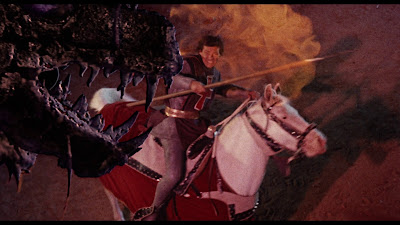---
The 1947 Miracle on 34th Street is iconic, a holiday classic. And deservedly so. It's witty, heartwarming, with superb performances by Edmund Gwenn as Kris Kringle, with supporting actors that include Natalie Wood, Maureen O'Hara, John Payne, Gene Lockhart, William Frawley, and Jack Albertson.
But there are others, and I want to discuss a 1955 TV version titled The Miracle on 34th Street. It's obscure but easily available. It's worth a viewing. It stars Thomas Mitchell as Kris Kringle and the cast includes Teresa Wright, Macdonald Carey, Sandy Descher, Hans Conreid, John Abbott, Whit Bissell and Dick Foran.
The Miracle on 34th Street would likely be forgotten today if not the archive of YouTube and other streaming websites. It's a brisk, lean 46-minute show, over before you know it. But it's a enjoyable near hour, a sort of homage cum remake of the 1947 classic.
Here are some key changes: Kris Kingle, played by Thomas Mitchell, does not get hired for the Macy's Parade because the other Santa is drunk. He's already the Macy's Santa. There is no character of Alfred, the teen janitor who Kris becomes a mentor to in the '47 film. Also, the very touching '47 film scene of Kris speaking Dutch to a young European orphan girl is omitted. However, Kris does advise shoppers to go to other stores, including Gimbels, if the deal is better there. And he has Descher's young Susan pull at his beard.
The omission of Alfred leads the plot with Mr. Sawyer, the unhappy Macy's psychologist, and his clash with Kris, in a different direction. Sawyer does interview Kris as part of his job, hates him and wants him fired. However, the episode where Kris knocks Sawyer over the head with his cane occurs at an assembly at Susan's' school, where Sawyer congratulates the students for not buying into supersition. During this scene, Kris, dressed in Santa garb, is -- unbeknownst to Sawyer -- behind him on the stage, mocking him.
The children can't help laughing and it's amusing for a while. Then, a flustered Sawyer berates adults who dress up as Santa. At this point, the scene takes a turn that today would seem very dark. Kris Kringle lifts his cane high and savagely brings it down on the unsuspecting Sawyer. This is a very harsh contrast to the '47 version, where a frustrated Kris sort of "pops" Sawyer on the head with his cane in his office. In the '47 version, it's clear Sawyer is maliciously feigning injury afterward.
However, this Kris Kringle really hits him hard, and frankly I think a month or two in the jail for assault might have been merited. This leads to a second point: Although Thomas Mitchell is not a bad Kris Kringle, unlike the more gentle Edmund Gwenn in the '47 version, the '54 version Kris Kingle is a bit of a looney. Mitchell's Kris Kringle occasionally has a mad look in his eyes, and he really gets angry. When Teresa Wright's Doris rushes after him to say he's not fired earlier in the film, the audience can see the deranged anger in Mitchell's eyes.
Neverthless, and happily I guess, Kris Kringle is of course exonorated by the judge. In another change from the '47 film, Doris calls the U.S. Post Office, suggesting they forward letters to Santa Claus to the court where Kris is being tried for his sanity.
One other little twist is a scene where MacDonald Carey's Fred Gailey has brought venison to a dinner with Kris, Doris, and little Susan. Doris suggests to Susan if she doesn't like venison, she'll make her eggs. Kris interjects, with a long face, that he would prefer eggs too, because well, venison being deer, he just couldn't eat that. It's a mildly amusing scene, worth a smile.
The Miracle on 34th Street was an episode of The 20th Century Fox Hour. It's' not the only other version of Miracle on 34th Street. There was a radio version, another TV version in 1959, and two mediocre conventional movie remakes. One, a TV film, is from 1974 with Sebastian Cablot as Kris Kingle. A theatrical version in 1994 had Sir Richard Attenborough as Kris.
But none approach the classic 1947 version, which remains the version to see first and often. However, I think this 1955 TV show version is the second-best offering. And it fits within an hour, for quick viewing with the family. You can watch it here. The two clippings from The Los Angeles Times were unearthed by my friend, David Grudt.
-- Doug Gibson

































